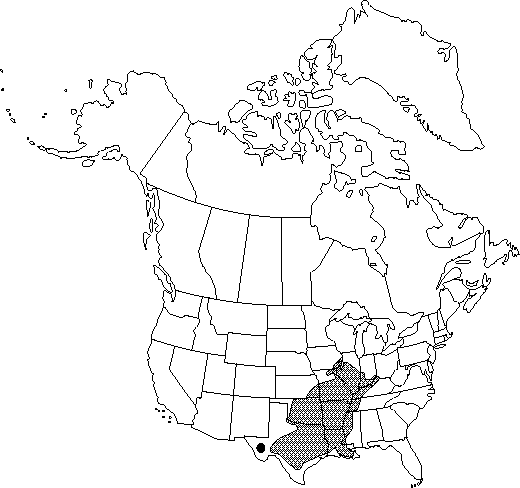Carya illinoinensis
Dendrologie 1: 593. 1869.
Trees, to 44 m. Bark light gray or brownish, ridged with appressed scales or exfoliating with small platelike scales. Twigs tan to reddish brown, slender, hirsute, conspicuously scaly, sometimes becoming glabrous. Terminal buds yellowish brown, oblong, 6-12 mm, hirsute, scaly; bud scales valvate; axillary buds protected by bracteoles fused into hood. Leaves 4-7 dm; petiole 4-8 cm, glabrous to scurfy with short single hairs or scattered fascicles. Leaflets (7-)9-13(-17), lateral petiolules 0-7 mm, terminal petiolules 5-25 mm; blades ovate-lanceolate, often falcate, 2-16 × 1-7 cm, margins finely to coarsely serrate, without tufts of hairs, apex acuminate; surfaces abaxially hirsute or with scattered unicellular and 2-rayed fasciculate hairs, scaly with large peltate scales and small round peltate scales, adaxially without hairs or rarely hirsute with unicellular hairs along midrib, and with scattered 2-6-rayed fasciculate hairs, moderately scaly in spring. Staminate catkins essentially sessile, to 18 cm, stalks with small capitate-glandular trichomes; anthers sparsely pilose. Fruits dark brown, ovoid-ellipsoid, not compressed, 2.5-6 × 1.5-3 cm; husks rough, 3-4 mm thick, dehiscing to base or nearly so, sutures winged; nuts tan to brown and mottled with black patches, ovoid-ellipsoid, not compressed, not angled, smooth; shells thin. Seeds sweet. 2n = 32.
Phenology: Flowering spring.
Habitat: Along stream banks, river flood plains, and on well-drained soils
Elevation: 0-600(-1000) m
Distribution

Ark., Ill., Ind., Iowa, Kans., Ky., La., Miss., Mo., Okla., Tenn., Tex., Mexico.
Discussion
Extensive cultivation and naturalization have confounded interpretation of the natural range of Carya illinoinensis. The pecan hybridizes with C. aquatica (C. ×lecontei Little [= Hicoria texana Le Conte]), C. cordiformis (C. ×brownii Sargent), C. laciniosa (C. ×nussbaumeri Sargent), and C. ovata, and reputedly with the tetraploid C. tomentosa (C. ×schneckii Sargent). J. W. Thieret (1961) pointed out that C. illinoinensis was the spelling Wangenheim used throughout his publication, and there is no valid basis for accepting the deviant spelling "illinoensis" that is so widely used today (E. L. Little Jr. 1979).
Carya illinoinensis is the state tree of Texas.
Native Americans used Carya illlinoinensis medicinally as a dermatological aid and as a remedy for tuberculosis (D. E. Moerman 1986).
Selected References
None.